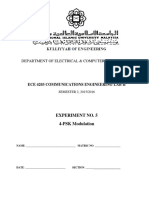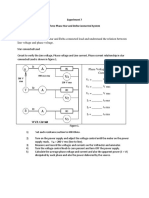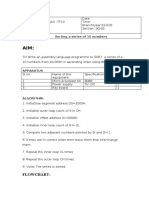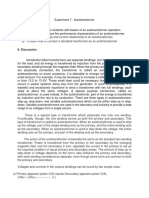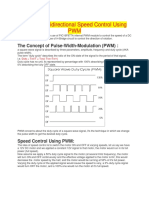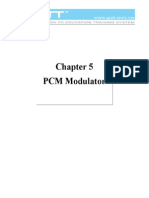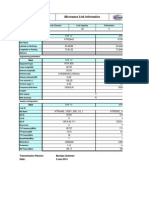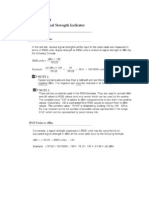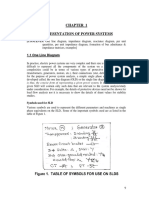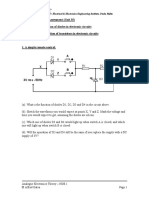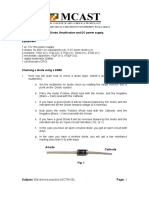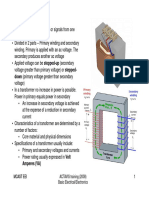Proteus Tutorial
Proteus Tutorial
Uploaded by
Alfred GaleaCopyright:
Available Formats
Proteus Tutorial
Proteus Tutorial
Uploaded by
Alfred GaleaOriginal Title
Copyright
Available Formats
Share this document
Did you find this document useful?
Is this content inappropriate?
Copyright:
Available Formats
Proteus Tutorial
Proteus Tutorial
Uploaded by
Alfred GaleaCopyright:
Available Formats
Institute for Electrical and Electronics Engineering, Paola, Malta.
Exercise 1: Construct and test a BJT Common Emitter Amplifier using Proteus.
Vcc = +12V
R1 RC
56k 4k7
Vout
C2
10uF
Vin C1 Q1
BC108
10uF
Vin Vout
1KHz
30mV ptop R2 RE CE
12k 1k 100uF
1. Generate a template with a title block on a landscape A4 sheet using Proteus.
2. Using Proteus, construct the circuit shown above.
3. Using dc voltmeter and ammeter, measure the values of Vb, Vc and Ve, and the
current taken by the circuit.
4. Connect the signal generator and monitor Vin and Vout using the CRO.
5. Adjust the generator to a frequency of 1KHz and an amplitude of 30 mV peak to
peak. Measure the peak to peak output signal (Vout). Print a screen shot showing
the CRO displaying the results.
6. Measure the values of Vin and Vout peak to peak and calculate the linear voltage
gain Av. Increase the amplitude of the input signal and note what happens to the
output signal in regard to wave shape and circuit gain. Explain reasons for the
distortion shown.
7. Set the amplitude of the signal generator back to 30mV peak to peak. Note what
happens to the output when you change the supply voltage to +5V and +30V.
Give reasons for any distortion shown
8. Replace R2 with a 47kΩ potentiometer. Change the circuit dc biasing by varying
R2. Note the effect on the output signal when you increase and when you
decrease the biasing. Give reasons for any distortion shown.
NDE 1 – Circuit Design Software Exercises. Page 1 of 5
© MCAST EEI – 2011/2012
Institute for Electrical and Electronics Engineering, Paola, Malta.
Exercise 2: Construct and test an FET Common Source Amplifier.
Vdd = +10V
R1
3k9
C2
10uF
C1 Q1
2N3819
10uF
Vout
Vin
1KHz
100mV ptop R3 R2 C3
100uF
1M 2k2
1. Using Proteus, construct the circuit shown above.
2. Animate the circuit and measure the dc values of Vd, Vs, Vg, Vgs, Vds,
Ig, Id and Is.
3. Connect a signal generator to Vin. Monitor Vin and Vout using the CRO.
4. Set the signal to a Sine Wave of frequency = 1KHz and amplitude =
100mV p to p.
5. Animate the circuit, measure the values of Vin and Vout and make a
screen shot showing the resulting waveforms produced by the CRO.
6. Using the values measured in step 5, calculate the dB gain of the circuit
at 1KHz
7. Using Proteus, produce a Frequency Response Graph for the circuit
above. Frequency Range must be between 10Hz and 100MHz.
8. Using Proteus, find the lower and upper cut off frequencies of the
amplifier. Find the bandwidth of the circuit.
9. Repeat steps 7 and 8 with capacitor C3 removed from the circuit. Note
what happens in terms of gain and bandwidth. Explain briefly the reason
for any change noticed in the results.
NDE 1 – Circuit Design Software Exercises. Page 2 of 5
© MCAST EEI – 2011/2012
Institute for Electrical and Electronics Engineering, Paola, Malta.
Exercise 3: Construct and test a Digital Combinational Logic Circuit.
1. Using Proteus, construct the logic circuit shown above.
2. Animate the circuit.
3. Apply all the input combinations. Note the output for each of the
combinations and produce a truth table for the circuit showing inputs A, B,
C, and D, and output Y.
4. Stop the animation. Connect a DC ammeter to measure the DC current
flowing between points E and F (Note: (+) to point E; (-) to point F; meter
set to milli Amps). Connect a DC voltmeter to measure the voltage present
at point G (Note: (+) to point G; (-) to ground).
5. Apply all the input combinations. For every combination note the current
flowing between points E and F, and the voltage present at point G. From
each current reading determine which from points E and F is sourcing
current, and which is sinking current. Hence determine the logic states at
point E. From the voltage readings, determine the logic states present at
point G.
6. Now, by replacing two logic gates from the circuit, modify the circuit so that
the following conditions are achieved:
a. Point E will be low only when input A is low and input C is high.
b. Point G will be high only when inputs B and C are low.
7. Indicate which gates will be replaced, and hence state the logic gates that
will be replacing them. Modify and animate the circuit. Produce a truth
table showing the logic states at points E and G at each input combination
of ABCD applied, so that you confirm the modification is working up to the
specifications given in step 6.
NDE 1 – Circuit Design Software Exercises. Page 3 of 5
© MCAST EEI – 2011/2012
Institute for Electrical and Electronics Engineering, Paola, Malta.
Exercise 4: Construct and analyse an Op-Amp as a Non-Inverting Amplifier.
1. Using Proteus software, construct the op-amp amplifier circuit shown above.
2. Connect a signal generator to the input and use the CRO to monitor Vin and
Vout.
3. Using a 1KHz, 100mV peak to peak sinewave input signal, measure the peak to
peak output signal. Make a print out of the resulting waveforms shown by the
CRO.
4. Using the results measured in step 3, verify the formula:
Av = 1 + R2/R1
5. Repeat step 3 using a Vin of 2V peak to peak and note what happens at Vout.
Comment about what you notice giving reasons for the comments..
6. Return Vin to 100mV peak to peak and use proteus to produce a Frequency
response graph for the frequency range 10Hz to 1MHz. Use the graph to
determine the bandwidth.
7. Repeat step 6 for every action indicated below. For each one note what happens
to the gain and the bandwidth of the circuit:
a. Replace C1 with a 2.2pF capacitor and C2 with a 1µF capacitor.
b. Replace C1 with a 100pF capacitor and C2 with a 10nF capacitor.
c. Replace R2 with a 47kΩ resistor.
NDE 1 – Circuit Design Software Exercises. Page 4 of 5
© MCAST EEI – 2011/2012
Institute for Electrical and Electronics Engineering, Paola, Malta.
Exercise 5: Construct and analyse an Op-Amp Inverting Amplifier.
1. Construct the circuit shown above on Proteus software.
2. Connect a signal generator to the circuit input (Vin) and monitor signals Vin
and Vout using the CRO.
3. Using a 2KHz, 200mV peak to peak sine wave as input signal, measure the
peak to peak output signal. Make a print out of the waveforms produced by
the CRO.
4. Using the values measured in step 3, verify the formula:
dB Gain = 20 x log (R2/R1)
5. Create a frequency response graph for the frequency range 10Hz to 1MHz.
Determine the bandwidth.
6. Replace one component from R1 and R2 to modify the circuit so that you get
a gain of 50db from the circuit. (You must make use of resistors with preferred
values according to E12 series)
7. Produce a screen shot print out showing the modified circuit producing a gain
of practically 50dB.
8. Repeat step 5 for the modified circuit. Note what happens to the bandwidth.
9. Make the value of R2 less than that of R1 and note why the circuit is called
‘Attenuator’ instead of ‘Amplifier’ when this is done.
10. With the values of R1 and R2 as shown in the figure given above, reduce the
value of C1 to 0.1µF and add a capacitor of 10pF in parallel with R2. Repeat
step 5 and compare the value of the bandwidth resulted with that obtained in
step 5. What do you notice? Hence state the function of these two capacitors
in the circuit.
NDE 1 – Circuit Design Software Exercises. Page 5 of 5
© MCAST EEI – 2011/2012
You might also like
- Experiment 5Document16 pagesExperiment 5Ravi Kanth M N33% (3)
- MPMC Lab Manual 15-11-2016Document139 pagesMPMC Lab Manual 15-11-2016k padmavathiNo ratings yet
- QPSKDocument11 pagesQPSKCesar Machado100% (1)
- Analog & Digital Communications Lab ManualDocument57 pagesAnalog & Digital Communications Lab ManualHarikrishnan Manakara RadhakrishnanNo ratings yet
- Experiment 7 Three Phase Star and Delta Connected System AimDocument3 pagesExperiment 7 Three Phase Star and Delta Connected System AimJanani Rangarajan100% (1)
- RC Differentiator & IntegratorDocument6 pagesRC Differentiator & IntegratorMatt Imri100% (1)
- DH Series: Air Circuit BreakersDocument4 pagesDH Series: Air Circuit BreakerskazishahNo ratings yet
- Sorting A Series of 10 Numbers: FlowchartDocument4 pagesSorting A Series of 10 Numbers: Flowchartnothing noNo ratings yet
- ITN Final PT Skills AssessmentDocument5 pagesITN Final PT Skills AssessmentAnisa NdociNo ratings yet
- 06119397Document6 pages06119397bpd21No ratings yet
- FM Balanced Slope DetectorDocument5 pagesFM Balanced Slope DetectorPujjalPandeyNo ratings yet
- LM7805 Voltage RegulatorDocument5 pagesLM7805 Voltage RegulatorDeepak SharmaNo ratings yet
- Chapter 4Document16 pagesChapter 4yoyokbintoroNo ratings yet
- Abb Ag: OperationDocument6 pagesAbb Ag: OperationCosmic Garash 2No ratings yet
- Engineering 4862 Microprocessors: Assignment 2Document6 pagesEngineering 4862 Microprocessors: Assignment 2Ermias MesfinNo ratings yet
- IC Regulated Power Supply TutorialDocument8 pagesIC Regulated Power Supply TutorialGugun GunawanNo ratings yet
- Amplitude Shift Keying Modulator DemodulatorDocument10 pagesAmplitude Shift Keying Modulator DemodulatorSandi M MNo ratings yet
- Lab MenualDocument206 pagesLab MenualMohammed Abdul Kader Sabuj0% (1)
- RCS-9700C BCUs For 61850 X Instruction Manual en Supplement ECKF100442-100445,100450 R1.01Document63 pagesRCS-9700C BCUs For 61850 X Instruction Manual en Supplement ECKF100442-100445,100450 R1.01Benigno Sayaboc TaradelNo ratings yet
- Smart AntennaDocument19 pagesSmart AntennaRashmiKanta100% (2)
- Experiment No:-07 DATE:24-09-20 Aim: To Realize Log and Antilog Amplifier Using Op-AmpDocument9 pagesExperiment No:-07 DATE:24-09-20 Aim: To Realize Log and Antilog Amplifier Using Op-AmpJainil ShahNo ratings yet
- Voltage Regulator (FINAL)Document33 pagesVoltage Regulator (FINAL)usama khattakNo ratings yet
- Unit 5 Sequential MOS Logic CircuitDocument21 pagesUnit 5 Sequential MOS Logic CircuitHarsh kumarNo ratings yet
- Edc Question Bank R20 2021Document5 pagesEdc Question Bank R20 2021khadarskb19No ratings yet
- Kathrein Edition 1Document16 pagesKathrein Edition 1Muhammad Mulia MaulanaNo ratings yet
- Experiment Kit For Study of Sample and Hold Circuit: User ManualDocument24 pagesExperiment Kit For Study of Sample and Hold Circuit: User ManualAshwani Kumar YadavNo ratings yet
- Rectangular Waveguide Design Using HFSSDocument1 pageRectangular Waveguide Design Using HFSSGECM85No ratings yet
- Lab - Experiment 3 Thevenin, Norton & Maximum Power TransferDocument6 pagesLab - Experiment 3 Thevenin, Norton & Maximum Power Transferعصير نفيشNo ratings yet
- Ee07lab Experiment AutotransformerDocument5 pagesEe07lab Experiment AutotransformerPido, Patricia LaineNo ratings yet
- Source Follower: (Common-Drain Amplifier)Document40 pagesSource Follower: (Common-Drain Amplifier)Benj MendozaNo ratings yet
- Laporan 2 Two PulseDocument27 pagesLaporan 2 Two PulseAlamsyah LaluNo ratings yet
- Edc Unit 5 1 ProblemsDocument24 pagesEdc Unit 5 1 ProblemsPoornimaNo ratings yet
- DC Motor Bidirectional Speed Control Using PWM PDFDocument5 pagesDC Motor Bidirectional Speed Control Using PWM PDFM Rameez Ur Rehman100% (1)
- Indoor Integrated Power System: TP48200B-N20B2Document8 pagesIndoor Integrated Power System: TP48200B-N20B2Equipo Técnico STLNo ratings yet
- Lab 7 (Cascaded Amplifier Design) - Sept 20Document8 pagesLab 7 (Cascaded Amplifier Design) - Sept 20WilfredNo ratings yet
- PIC Instruction SetDocument64 pagesPIC Instruction SetHiru Purushothaman Hirudayanathan100% (2)
- Chapter 5 PCM ModDocument12 pagesChapter 5 PCM Modarvinabdillah100% (1)
- Engineer Info Report KTR2443 KTR0502 Link 1 130521-191125Document29 pagesEngineer Info Report KTR2443 KTR0502 Link 1 130521-191125Muhammad KashifNo ratings yet
- Multi SimDocument27 pagesMulti Simera_terNo ratings yet
- RSSI CalculationDocument6 pagesRSSI CalculationViet AnhNo ratings yet
- EDC Question BankDocument13 pagesEDC Question BankvenzkrishNo ratings yet
- Representation of Power Systems: 1.1 One Line DiagramDocument17 pagesRepresentation of Power Systems: 1.1 One Line DiagramDr. Gollapalli Naresh100% (1)
- EEE 2210-Analogue Electronics II-PrintreadyDocument4 pagesEEE 2210-Analogue Electronics II-PrintreadyMike ShakespeareNo ratings yet
- Chapter 8 Microwave FiltersDocument53 pagesChapter 8 Microwave FilterskhyatichavdaNo ratings yet
- Digital Modulation PDFDocument41 pagesDigital Modulation PDFPabitraMandal100% (1)
- Manual de Serviço Cybernet Am:Fm:Ssb Export CB Radios Service 2019-7-24Document27 pagesManual de Serviço Cybernet Am:Fm:Ssb Export CB Radios Service 2019-7-24gilsongpsNo ratings yet
- 11-Khusnul Khotimah-TT2E-MEC Dan Load FigureDocument22 pages11-Khusnul Khotimah-TT2E-MEC Dan Load Figurekhusnul khotimahNo ratings yet
- Class A Power Amplifier (MOSFET)Document5 pagesClass A Power Amplifier (MOSFET)Tom ShibuNo ratings yet
- Half Wave and Full Wave RectifierDocument10 pagesHalf Wave and Full Wave RectifiersunilsathishNo ratings yet
- Power Electronics Experiments ECE-P-672Document9 pagesPower Electronics Experiments ECE-P-672Sai SomayajulaNo ratings yet
- LM2907 LM2917 Conversor F - VDocument18 pagesLM2907 LM2917 Conversor F - VAlejandra Vasquez GiraldoNo ratings yet
- Engineer Info Report PLD2238 PLD7800 Link 1 130715-155354Document34 pagesEngineer Info Report PLD2238 PLD7800 Link 1 130715-155354Muhammad KashifNo ratings yet
- Chapter 7 Amplifier Frequency ResponseDocument32 pagesChapter 7 Amplifier Frequency ResponseHappy SmileNo ratings yet
- High-Gain Differential Amplifier DesignDocument21 pagesHigh-Gain Differential Amplifier DesignBodhayan PrasadNo ratings yet
- P6 Practical TutorialDocument6 pagesP6 Practical TutorialAlfred GaleaNo ratings yet
- Actavis Electronics Session 10Document14 pagesActavis Electronics Session 10Alfred GaleaNo ratings yet
- Op-Amps Notes - NDE 1Document13 pagesOp-Amps Notes - NDE 1Alfred GaleaNo ratings yet
- Op-Amps 2Document4 pagesOp-Amps 2Alfred GaleaNo ratings yet
- Actavis - Electronics - Session - 13 (Compatibility Mode)Document14 pagesActavis - Electronics - Session - 13 (Compatibility Mode)Alfred GaleaNo ratings yet
- P3M3 Tutorial - 0910 - 1Document2 pagesP3M3 Tutorial - 0910 - 1Alfred GaleaNo ratings yet
- 1 - Logic GatesDocument7 pages1 - Logic GatesAlfred GaleaNo ratings yet
- P1P2 TutorialDocument11 pagesP1P2 TutorialAlfred GaleaNo ratings yet
- Actavis - Electronics - Session - 12 (Compatibility Mode)Document15 pagesActavis - Electronics - Session - 12 (Compatibility Mode)Alfred GaleaNo ratings yet
- Digital Notes - 1Document18 pagesDigital Notes - 1Alfred GaleaNo ratings yet
- Diode Power Supply ExperimentDocument6 pagesDiode Power Supply ExperimentAlfred GaleaNo ratings yet
- Three-Terminal Positive Fixed Voltage Regulators: Semiconductor Technical DataDocument4 pagesThree-Terminal Positive Fixed Voltage Regulators: Semiconductor Technical DataAlfred GaleaNo ratings yet
- Soldering NotesDocument7 pagesSoldering NotesAlfred Galea100% (1)
- Using The MultimeterDocument5 pagesUsing The MultimeterAlfred GaleaNo ratings yet
- Subject:: Electronics Lab (Linear) 1Document6 pagesSubject:: Electronics Lab (Linear) 1Alfred GaleaNo ratings yet
- Safety and Protection Required by An Electrical Installation: Electrical Bonding To Earth (Earthing)Document9 pagesSafety and Protection Required by An Electrical Installation: Electrical Bonding To Earth (Earthing)Alfred GaleaNo ratings yet
- Electrical Wiring The IEE Wiring RegulationsDocument28 pagesElectrical Wiring The IEE Wiring RegulationsAlfred GaleaNo ratings yet
- Actavis Notes - Session6 - Elex (Compatibility Mode)Document14 pagesActavis Notes - Session6 - Elex (Compatibility Mode)Alfred GaleaNo ratings yet
- Electrical Machines (Motors and Generators) Basic Concepts (Cont) : Basic Concepts (Cont.)Document5 pagesElectrical Machines (Motors and Generators) Basic Concepts (Cont) : Basic Concepts (Cont.)Alfred GaleaNo ratings yet
- Capacitors and Capacitance: ElectrostaticsDocument28 pagesCapacitors and Capacitance: ElectrostaticsAlfred GaleaNo ratings yet
- The Resistor: The Carbon Type Resistor:: Mcast Eei NDE1: Unit 35 Electronics Applications 1Document13 pagesThe Resistor: The Carbon Type Resistor:: Mcast Eei NDE1: Unit 35 Electronics Applications 1Alfred GaleaNo ratings yet
- Subject: Electronics Lab (Analog) Class: NDE 1Document10 pagesSubject: Electronics Lab (Analog) Class: NDE 1Alfred GaleaNo ratings yet
- Colour Coding ExerciseDocument4 pagesColour Coding ExerciseAlfred GaleaNo ratings yet
- Series and Parallel Resistor Circuits: R2 R3 R4 R5Document2 pagesSeries and Parallel Resistor Circuits: R2 R3 R4 R5Alfred GaleaNo ratings yet
- Subject: Basic Electrical and Electronics Principles: Training Programme For ACTAVIS Employees (2008/2009)Document18 pagesSubject: Basic Electrical and Electronics Principles: Training Programme For ACTAVIS Employees (2008/2009)Alfred GaleaNo ratings yet
- Electronic ComponentsDocument53 pagesElectronic ComponentsAlfred GaleaNo ratings yet
- Analog Thoery Resistors Exercise 1 PDFDocument2 pagesAnalog Thoery Resistors Exercise 1 PDFAlfred GaleaNo ratings yet
- Experiment 1 - Series and Parallel Resistor Circuits: Background InformationDocument8 pagesExperiment 1 - Series and Parallel Resistor Circuits: Background InformationAlfred GaleaNo ratings yet
- Transformers:: Mcast Eei 1 ACTAVIS Training (2008) Basic Electrical/Electronics Mcast Eei 1Document26 pagesTransformers:: Mcast Eei 1 ACTAVIS Training (2008) Basic Electrical/Electronics Mcast Eei 1Alfred GaleaNo ratings yet


